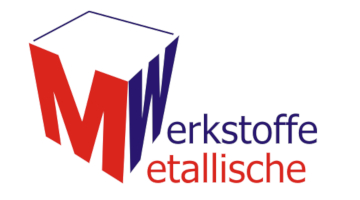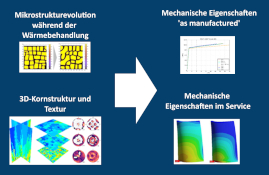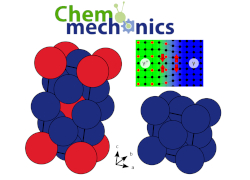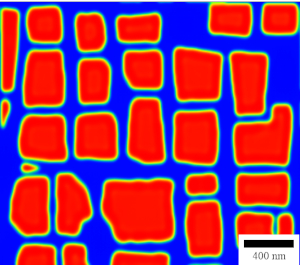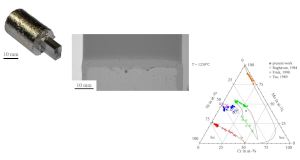Modelling und Simulation - Projects
Fields of Activity
The development of models and their implementation in new parallelizable programs for simulation is indispensable in many areas of industry and research. These simulations lead to new insights and can help to perform experiments in a more targeted and effective way. With the help of commercial but also self-developed programs that are suitable for parallelization at the three computer clusters, the working group "Modeling and Simulation" complements and supports the work at the Chair for Metals and Alloys.
- SAPHIR- Modeling mechanical properties of additively manufactured polycrystalline nickel-base superalloysHide
-
Contact: Moritz Müller
The goal of the project is the prediction of mechanical properties of additively manufactured turbine parts made from selected nickel-base superalloys, during production, heat-treatment, and service life. The underlying microstructure will be simulated based on alloy composition and process parameters. These results combined with additional material parameters will be used to deduce mechanical properties. Results of simulations and models will be calibrated and compared to experimental results, like tensile- or creep tests.
The resulting description ranging from production over heat-treatment to service life will be used for the development of new alloys and processes for additive manufacturing of nickel-based superalloys.
- Formation of thermally-induced crack patterns in anisotropic, fiber- reinforced composites with a brittle matrixHide
-
Contact: Michael Fleck
The excellent thermo-mechanical properties of fiber-reinforced composites with a brittle matrix are decisively dependent on production related, thermally induced crack patterns. The cause of these crack patterns are local tensile stresses, which result from the combination of rigid fibers in a thermally induced shrinking matrix. In the planned project the formation of crack patterns is investigated in a combined approach of new fracture mechanics simulations based on the phase field method together with systematic, tailor-made experiments.
The special feature of the planned project lies in the close interaction between simulation and experiment, which manifests itself in two ways. On the one hand, the simulation studies as well as the experimental campaign are both concerned with the investigation of the effect of variations of accessible material and process parameters, such as the fiber volume fraction, the heating rate, as well as the fiber matrix bond. On the other hand, the complexity of the underlying microstructure is increased step by step in the experiment as well as in the simulation by variations of the type of reinforcement.
In the experiment, the investigation of the formation of crack patterns is carried out in-situ in the heating cell and, on the other hand, by systematic interruption of the pyrolysis process followed by a comprehensive characterization of the respective samples. In an iterative approach, different types of reinforcement are investigated. The geometric complexity of the microstructure is gradually increased: From unreinforced through unidirectional over alternating 0/90° laminates to tissues. The crack patterns occurring in the experiment are quantitatively measured, analyzed and compared with the crack patterns observed in the simulation. As input parameters for the simulations, the anisotropic shrinkage behavior, the stiffnesses and the fracture toughness of different composites as well as pure matrices are determined as a function of the pyrolysis progress.
The use of simulations enables the mechanism-oriented investigation of the formation of thermally-induced crack patterns. Two hierarchically nested models are used for the respective description of brittle crack growth on the different length scales. On a microscopic length scale, both the fibers and the matrix are each modeled as separate brittle-cracking phases with different mechanical properties. On the higher mesoscale, whole fiber bundles are then each described as homogeneous, brittle phases with the homogenized material properties of a unidirectional fiber-matrix composite.
Upon successful completion of the research project, it is expected that for the increasingly important class of fiber-reinforced composite materials with a brittle matrix (e.g. C/C, C/C-SiC) a comprehensive understanding of the correlation between thermally induced crack patterns and the fiber matrix bond and the resulting composite properties will be present.
- Phase-field modelling of coarsening and growth of metastable γ″-precipitates in Ni-base superalloysHide
-
Contact: Felix Schleifer
In this project a phase field model is developed for the simulation of diffusion limited precipitation in nickel-base superalloys. The alloy Inconel 718 owes its excellent high temperature properties to coherent γ" precipitates in an fcc matrix phase. This metastable intermetallic phase with its tetragonal structure contributes significantly to the mechanical strength of the alloy.
The thermodynamic formulation of the model is validated with CALPHAD calculations of the equilibrium states. It also considers elastic effects to describe external loads, anisotropic lattice misfit and elastic inhomogeneities between phases.
The project is part of the DFG Priority Program 1713 (http://gepris.dfg.de/gepris/projekt/237105621). The main objective is to study the growth and coarsening of precipitate particles as a function of the heat treatment parameters time and temperature.
- ParaPhase - Space-time parallel adaptive simulation of phase field models on supercomputers.Hide
-
Contact: Markus Holzinger
Segregation and phase transformations in metallic multi-component alloys (e.g. nickel-based superalloys) are of crucial importance for the development of specific materials with special properties. In this project, the phase field simulation method will be improved using modern, highly parallelized algorithms.
- High temperature single crystal and material simulationHide
-
Contact: Robert Popp
The aim of the project is to advance the thermodynamic modeling of intermetallic phases in multicomponent systems. For the necessary improvement of the existing databases, the method of "diffusion multiples" is used, in which interdiffusion zones are generated from different elemental components by isothermal long-term annealing. The quantitative analysis of the interdiffusion zones in combination with the structure determination of the phases allows the extraction of thermodynamic quantities for input into corresponding databases.

